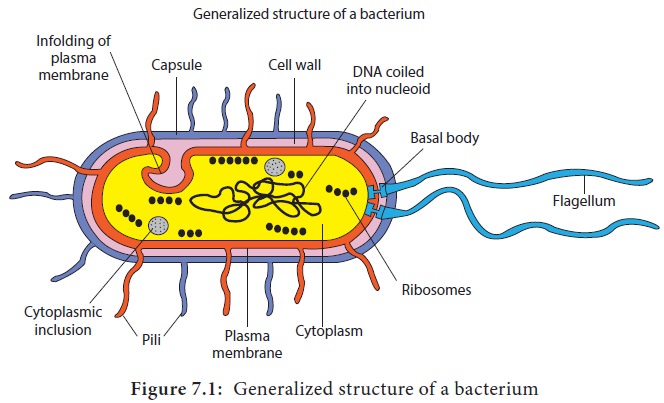Chapter: 11th Microbiology : Chapter 7 : Morphology of Bacteria
Structure of Bacteria Cytoplasmic Membrane
Structure of Cytoplasmic Membrane
Immediately beneath the cell wall is the cytoplasmic membrane
also known as plasma membrane or cell membrane. It is composed of phospholipids
and proteins. The phospholipids form a bilayer. Integral proteins are embedded
within this bilayer. Surface proteins or peripheral proteins are loosely
attached to the bilayer. The lipid matrix of the membrane has fluidity, allowing
the components to move around laterally. In eubacteria, the phospholipids are
phosphoglycerides, in which straight chain fatty acids are ester linked to
glycerol. In archaeobacteria, the lipids are polyisoprenoid branched-chain
lipids, in which long-chain branched alcohols (phytanols) are ether linked to
glycerol.
Functions of the cell membrane
·
Prokaryotes do not have intracellular membrane bound organelles
as present in eukaryotic organelles. Thus cell membrane provides a site for
functions such as energy reactions, nutrient processing and synthesis.
·
It regulates transport, the passage of nutrients into the cell
and the discharge of wastes. It is a selectively permeable membrane.
·
It is also involved in secretion or discharge of a metabolic
product into extracellular environment.
·
Cell membrane is an important site for a number of metabolic
activities. Most enzymes of respiration and ATP synthesis reside in the cell
membrane since prokaryotes lack mitochondria.
Significance of cell envelope
·
It has toxic properties (Example: LPS)
·
It stimulates antibody production by immune system
·
The cell walls of many pathogens have components that contribute
to their pathogenicity. Example mycolic acids of Mycobacterium tuberculosis
·
Cell wall is a site of action of several antibiotics.
·
Many of the serological properties of Gram negative bacteria are
attributable to O antigens; they can also serve as receptors for bacteriophage
attachment.

Related Topics